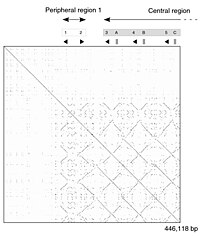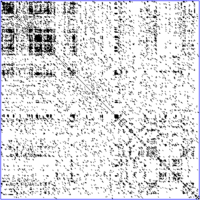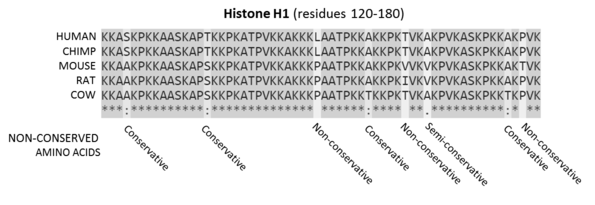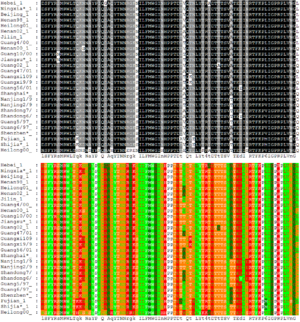Alignment Methods
Contents
Sequence alignment
From Wikipedia, the free encyclopedia
In bioinformatics, a sequence alignment is a way of arranging the sequences of DNA, RNA, or protein to identify regions of similarity that may be a consequence of functional, structural, or evolutionary relationships between the sequences.[1] Aligned sequences of nucleotide or amino acid residues are typically represented as rows within a matrix. Gaps are inserted between the residues so that identical or similar characters are aligned in successive columns. Sequence alignments are also used for non-biological sequences, such as calculating the edit distance cost between strings in a natural language or in financial data.
A sequence alignment, produced by ClustalO, of mammalian histone proteins.
Sequences are the amino acids for residues 120-180 of the proteins. Residues that are conserved across all sequences are highlighted in grey. Below the protein sequences is a key denoting conserved sequence (*), conservative mutations (:), semi-conservative mutations (.), and non-conservative mutations ( ).[2]
Pairwise alignment
Pairwise sequence alignment methods are used to find the best-matching piecewise (local or global) alignments of two query sequences. Pairwise alignments can only be used between two sequences at a time, but they are efficient to calculate and are often used for methods that do not require extreme precision (such as searching a database for sequences with high similarity to a query). The three primary methods of producing pairwise alignments are dot-matrix methods, dynamic programming, and word methods;[1] however, multiple sequence alignment techniques can also align pairs of sequences. Although each method has its individual strengths and weaknesses, all three pairwise methods have difficulty with highly repetitive sequences of low information content - especially where the number of repetitions differ in the two sequences to be aligned. One way of quantifying the utility of a given pairwise alignment is the 'maximum unique match' (MUM), or the longest subsequence that occurs in both query sequences. Longer MUM sequences typically reflect closer relatedness.
Dot-matrix methods

Self comparison of a part of a mouse strain genome. The dot-plot shows a patchwork of lines, demonstrating duplicated segments of DNA. |
See main article on dot plots (bioinformatics).

A DNA dot plot of a humanzinc finger transcription factor(GenBank ID NM_002383), showing regional self-similarity. The main diagonal represents the sequence's alignment with itself; lines off the main diagonal represent similar or repetitive patterns within the sequence. This is a typical example of a recurrence plot. |
The dot-matrix approach, which implicitly produces a family of alignments for individual sequence regions, is qualitative and conceptually simple, though time-consuming to analyze on a large scale. In the absence of noise, it can be easy to visually identify certain sequence features—such as insertions, deletions, repeats, or inverted repeats—from a dot-matrix plot. To construct a dot-matrix plot, the two sequences are written along the top row and leftmost column of a two-dimensional matrix and a dot is placed at any point where the characters in the appropriate columns match—this is a typical recurrence plot. Some implementations vary the size or intensity of the dot depending on the degree of similarity of the two characters, to accommodate conservative substitutions. The dot plots of very closely related sequences will appear as a single line along the matrix's main diagonal.
Problems with dot plots as an information display technique include: noise, lack of clarity, non-intuitiveness, difficulty extracting match summary statistics and match positions on the two sequences. There is also much wasted space where the match data is inherently duplicated across the diagonal and most of the actual area of the plot is taken up by either empty space or noise, and, finally, dot-plots are limited to two sequences. None of these limitations apply to Miropeats alignment diagrams but they have their own particular flaws.
Dot plots can also be used to assess repetitiveness in a single sequence. A sequence can be plotted against itself and regions that share significant similarities will appear as lines off the main diagonal. This effect can occur when a protein consists of multiple similar structural domains.
Dynamic programming
The technique of dynamic programming can be applied to produce global alignments via the Needleman-Wunsch algorithm, and local alignments via the Smith-Waterman algorithm. In typical usage, protein alignments use a substitution matrix to assign scores to amino-acid matches or mismatches, and a gap penalty for matching an amino acid in one sequence to a gap in the other. DNA and RNA alignments may use a scoring matrix, but in practice often simply assign a positive match score, a negative mismatch score, and a negative gap penalty. (In standard dynamic programming, the score of each amino acid position is independent of the identity of its neighbors, and therefore base stacking effects are not taken into account. However, it is possible to account for such effects by modifying the algorithm.) A common extension to standard linear gap costs, is the usage of two different gap penalties for opening a gap and for extending a gap. Typically the former is much larger than the latter, e.g. -10 for gap open and -2 for gap extension. Thus, the number of gaps in an alignment is usually reduced and residues and gaps are kept together, which typically makes more biological sense. The Gotoh algorithm implements affine gap costs by using three matrices.
Dynamic programming can be useful in aligning nucleotide to protein sequences, a task complicated by the need to take into account frameshift mutations (usually insertions or deletions). The framesearch method produces a series of global or local pairwise alignments between a query nucleotide sequence and a search set of protein sequences, or vice versa. Its ability to evaluate frameshifts offset by an arbitrary number of nucleotides makes the method useful for sequences containing large numbers of indels, which can be very difficult to align with more efficient heuristic methods. In practice, the method requires large amounts of computing power or a system whose architecture is specialized for dynamic programming. The BLAST and EMBOSS suites provide basic tools for creating translated alignments (though some of these approaches take advantage of side-effects of sequence searching capabilities of the tools). More general methods are available from both commercial sources, such as FrameSearch, distributed as part of the Accelrys GCG package, and Open Source software such as Genewise.
The dynamic programming method is guaranteed to find an optimal alignment given a particular scoring function; however, identifying a good scoring function is often an empirical rather than a theoretical matter. Although dynamic programming is extensible to more than two sequences, it is prohibitively slow for large numbers of sequences or extremely long sequences.
Word methods
Word methods, also known as k-tuple methods, are heuristic methods that are not guaranteed to find an optimal alignment solution, but are significantly more efficient than dynamic programming. These methods are especially useful in large-scale database searches where it is understood that a large proportion of the candidate sequences will have essentially no significant match with the query sequence. Word methods are best known for their implementation in the database search tools FASTA and the BLAST family.[1] Word methods identify a series of short, nonoverlapping subsequences ("words") in the query sequence that are then matched to candidate database sequences. The relative positions of the word in the two sequences being compared are subtracted to obtain an offset; this will indicate a region of alignment if multiple distinct words produce the same offset. Only if this region is detected do these methods apply more sensitive alignment criteria; thus, many unnecessary comparisons with sequences of no appreciable similarity are eliminated.
In the FASTA method, the user defines a value k to use as the word length with which to search the database. The method is slower but more sensitive at lower values of k, which are also preferred for searches involving a very short query sequence. The BLAST family of search methods provides a number of algorithms optimized for particular types of queries, such as searching for distantly related sequence matches. BLAST was developed to provide a faster alternative to FASTA without sacrificing much accuracy; like FASTA, BLAST uses a word search of length k, but evaluates only the most significant word matches, rather than every word match as does FASTA. Most BLAST implementations use a fixed default word length that is optimized for the query and database type, and that is changed only under special circumstances, such as when searching with repetitive or very short query sequences. Implementations can be found via a number of web portals, such as EMBL FASTA and NCBI BLAST.
Multiple sequence alignment
Main article: Multiple sequence alignment
Alignment of 27 avian influenza hemagglutininprotein sequences colored by residue conservation (top) and residue properties (bottom)
Multiple sequence alignment is an extension of pairwise alignment to incorporate more than two sequences at a time. Multiple alignment methods try to align all of the sequences in a given query set. Multiple alignments are often used in identifying conserved sequence regions across a group of sequences hypothesized to be evolutionarily related. Such conserved sequence motifs can be used in conjunction with structural and mechanistic information to locate the catalytic active sites of enzymes. Alignments are also used to aid in establishing evolutionary relationships by constructing phylogenetic trees. Multiple sequence alignments are computationally difficult to produce and most formulations of the problem lead to NP-complete combinatorial optimization problems.[8][9] Nevertheless, the utility of these alignments in bioinformatics has led to the development of a variety of methods suitable for aligning three or more sequences.
Dynamic programming
The technique of dynamic programming is theoretically applicable to any number of sequences; however, because it is computationally expensive in both time and memory, it is rarely used for more than three or four sequences in its most basic form. This method requires constructing the n-dimensional equivalent of the sequence matrix formed from two sequences, where n is the number of sequences in the query. Standard dynamic programming is first used on all pairs of query sequences and then the "alignment space" is filled in by considering possible matches or gaps at intermediate positions, eventually constructing an alignment essentially between each two-sequence alignment. Although this technique is computationally expensive, its guarantee of a global optimum solution is useful in cases where only a few sequences need to be aligned accurately. One method for reducing the computational demands of dynamic programming, which relies on the "sum of pairs" objective function, has been implemented in the MSA software package.[10]
Progressive methods
Progressive, hierarchical, or tree methods generate a multiple sequence alignment by first aligning the most similar sequences and then adding successively less related sequences or groups to the alignment until the entire query set has been incorporated into the solution. The initial tree describing the sequence relatedness is based on pairwise comparisons that may include heuristic pairwise alignment methods similar to FASTA. Progressive alignment results are dependent on the choice of "most related" sequences and thus can be sensitive to inaccuracies in the initial pairwise alignments. Most progressive multiple sequence alignment methods additionally weight the sequences in the query set according to their relatedness, which reduces the likelihood of making a poor choice of initial sequences and thus improves alignment accuracy.
Many variations of the Clustal progressive implementation[11][12][13] are used for multiple sequence alignment, phylogenetic tree construction, and as input for protein structure prediction. A slower but more accurate variant of the progressive method is known as T-Coffee.[14]
Iterative methods
Iterative methods attempt to improve on the heavy dependence on the accuracy of the initial pairwise alignments, which is the weak point of the progressive methods. Iterative methods optimize an objective function based on a selected alignment scoring method by assigning an initial global alignment and then realigning sequence subsets. The realigned subsets are then themselves aligned to produce the next iteration's multiple sequence alignment. Various ways of selecting the sequence subgroups and objective function are reviewed in.[15]
Motif finding
Motif finding, also known as profile analysis, constructs global multiple sequence alignments that attempt to align short conserved sequence motifs among the sequences in the query set. This is usually done by first constructing a general global multiple sequence alignment, after which the highly conserved regions are isolated and used to construct a set of profile matrices. The profile matrix for each conserved region is arranged like a scoring matrix but its frequency counts for each amino acid or nucleotide at each position are derived from the conserved region's character distribution rather than from a more general empirical distribution. The profile matrices are then used to search other sequences for occurrences of the motif they characterize. In cases where the original data set contained a small number of sequences, or only highly related sequences, pseudocounts are added to normalize the character distributions represented in the motif.
Techniques inspired by computer science
A variety of general optimization algorithms commonly used in computer science have also been applied to the multiple sequence alignment problem. Hidden Markov models have been used to produce probability scores for a family of possible multiple sequence alignments for a given query set; although early HMM-based methods produced underwhelming performance, later applications have found them especially effective in detecting remotely related sequences because they are less susceptible to noise created by conservative or semiconservative substitutions.[16] Genetic algorithms and simulated annealing have also been used in optimizing multiple sequence alignment scores as judged by a scoring function like the sum-of-pairs method. More complete details and software packages can be found in the main article multiple sequence alignment.
The Burrows–Wheeler transform has been successfully applied to fast short read alignment in popular tools such as Bowtie and BWA. See FM-index.
Structural alignment
Main article: Structural alignment
Structural alignments, which are usually specific to protein and sometimes RNA sequences, use information about the secondary and tertiary structure of the protein or RNA molecule to aid in aligning the sequences. These methods can be used for two or more sequences and typically produce local alignments; however, because they depend on the availability of structural information, they can only be used for sequences whose corresponding structures are known (usually through X-ray crystallography or NMR spectroscopy). Because both protein and RNA structure is more evolutionarily conserved than sequence,[17] structural alignments can be more reliable between sequences that are very distantly related and that have diverged so extensively that sequence comparison cannot reliably detect their similarity.
Structural alignments are used as the "gold standard" in evaluating alignments for homology-based protein structure prediction[18] because they explicitly align regions of the protein sequence that are structurally similar rather than relying exclusively on sequence information. However, clearly structural alignments cannot be used in structure prediction because at least one sequence in the query set is the target to be modeled, for which the structure is not known. It has been shown that, given the structural alignment between a target and a template sequence, highly accurate models of the target protein sequence can be produced; a major stumbling block in homology-based structure prediction is the production of structurally accurate alignments given only sequence information.[18]
DALI
The DALI method, or distance matrix alignment, is a fragment-based method for constructing structural alignments based on contact similarity patterns between successive hexapeptides in the query sequences.[19] It can generate pairwise or multiple alignments and identify a query sequence's structural neighbors in the Protein Data Bank (PDB). It has been used to construct the FSSP structural alignment database (Fold classification based on Structure-Structure alignment of Proteins, or Families of Structurally Similar Proteins). A DALI webserver can be accessed at DALI and the FSSP is located at The Dali Database.
SSAP
SSAP (sequential structure alignment program) is a dynamic programming-based method of structural alignment that uses atom-to-atom vectors in structure space as comparison points. It has been extended since its original description to include multiple as well as pairwise alignments,[20] and has been used in the construction of the CATH (Class, Architecture, Topology, Homology) hierarchical database classification of protein folds.[21] The CATH database can be accessed at CATH Protein Structure Classification.
Combinatorial extension
The combinatorial extension method of structural alignment generates a pairwise structural alignment by using local geometry to align short fragments of the two proteins being analyzed and then assembles these fragments into a larger alignment.[22] Based on measures such as rigid-body root mean square distance, residue distances, local secondary structure, and surrounding environmental features such as residue neighbor hydrophobicity, local alignments called "aligned fragment pairs" are generated and used to build a similarity matrix representing all possible structural alignments within predefined cutoff criteria. A path from one protein structure state to the other is then traced through the matrix by extending the growing alignment one fragment at a time. The optimal such path defines the combinatorial-extension alignment. A web-based server implementing the method and providing a database of pairwise alignments of structures in the Protein Data Bank is located at the Combinatorial Extension website.

